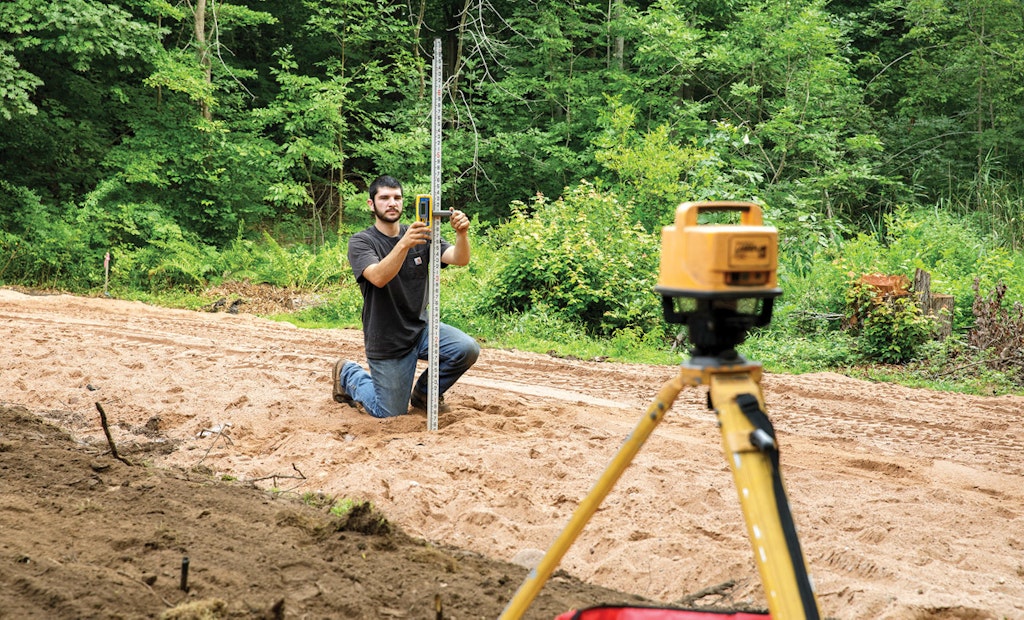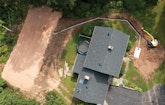
Mike Camarota uses a Spectra Precision LL500 laser level to determine the grade for a distribution box installation. (Photos by John Marinelli)
It wouldn’t be an exaggeration to say that Mike Camarota Jr. has been preparing for his career as a businessman and septic system installer since he was 12 years old.
That’s when the 24-year-old owner of Camarota Sanitation & Excavation started a lawn-mowing and landscaping business that taught him the basics of business — things such as paying bills, managing customers’ expectations, building client relationships and developing accurate job estimates.
“It’s true that I laid the groundwork for business early,” says Camarota. “My dad has a strong work ethic and I guess it rubbed off on me. I just like to work, I guess.”
Camarota, of Gilford, Connecticut, began his classic small-business journey with a 1963 Simplicity riding mower. By the time he graduated from high school, he had amassed more than 100 customers, employed four friends and owned several lawnmowers. And his services included mowing lawns, mulching flower beds, top-soiling yards and building retaining walls.
The young entrepreneur also worked for his father, Mike Camarota Sr., who owned an excavating business with his father; the company’s services included septic system installations, Camarota says.
But Camarota eventually got bored with landscaping work, so he instead set his sights on the septic industry. “I got aggravated because landscaping became mindless work — the same thing every week,” he recalls. “So my dad suggested that I buy a pump truck and start pumping out septic tanks.
“I found a 2000 International 4900 and bought it for $25,000,” he continues. “My customers were upset that I got out of landscaping, but they understood where I was coming from. And as it turned out, I was able to serve them in a different way because many of them needed excavation work or septic tanks pumped.”
DIVERSE SERVICES
Today, Camarota installs systems, pumps tanks, inspects and designs septic systems and does pipeline inspections and locating. Pumping out tanks generates about 10 to 15% of his company’s revenue, and he still uses the same service truck with a 2,500-gallon steel tank and a Jurop vacuum pump.
“It’s the perfect size for what I do,” he notes, which is pump out three or four tanks a week. “It’s hard to compete with other guys around here that have giant customer bases and multiple trucks. They can offer cheaper prices and have been in business forever. But they don’t do repair work, which helps out.”
Camarota generally installs two to three systems a month, many conventional gravity systems. He employs Mantis leaching systems from Eljen Corp. and designed for sites with limited space, and the Geomat leachfield product, from Geomatrix Systems.
The soil in Connecticut poses challenges for installers, ranging from gravel-laden dirt to clay — and everything in between. “We have just about every kind of soil you can imagine,” Camarota says. “Lots of boulders, too.
“And the worse the soil is, the more expensive it is to install systems and the harder they are to install,” he adds. “More often than not, we bring in material like septic sand to make the soil more suitable or to build up a site, rather than excavating it.”
A FAST LEARNER
How did Camarota transition to installing systems? For starters, he already had a solid customer base from his prior business, which underscores the importance of developing long-term relationships with clients. In addition, Camarota had helped his father install septic systems for years when he was younger.
Camarota earned a state-issued installer’s license, which also covers repairing systems and pumping tanks. In addition, he took a short course offered by the Connecticut Onsite Wastewater Recycling Association that covered pumping tanks and system installations, he says.
While he was confident he could handle installations, he says his first job still was a little nerve-racking. “I called my dad five times,” he says. “Things got real really fast.
“But I had experience running machines my whole life and loved working with them,” he continues. “In fact, when my mom would sign me up for summer camps, I’d go, then pretend to be sick so I could stay home and work with my dad. I wouldn’t last a half hour at those camps.”
EQUIPPED FOR SUCCESS
The company owns a full range of excavating equipment. The fleet includes a 2005 Kobelco SK70 midsize excavator, a 1999 Bobcat 873 skid-steer loader; a 2002 EX27 mini-excavator built by Airman Hokuetsu Industries; a SE210LC full-size Samsung excavator; and a John Deere excavator.
Vehicles include a 2002 Ford F-350 pickup truck with a Reading Truck Body utility body; a 2006 Ford F-350 that carries a 9-foot Rugby Manufacturing dump bed; and a 1998 GMC C7500 dump truck with a 9-foot Galion-Godwin Truck Body bed.
Camarota also relies on a 1000S pipeline-inspection camera from Kyrie Sewer Cameras; a Mustang cart-mounted water jetter (2,00 psi at 2 gpm); a Stihl concrete saw; and a Spectra Precision LL500 laser level from Trimble.
One key to the company’s success is continual investments in equipment that helps him work more productively and boost profit margins. Another success factor stems from lessons learned early on in his landscaping career: Don’t reduce prices in order to woo cost-conscious customers, he says.
“You shouldn’t sell yourself short for customers just to get their business,” he explains. “If you price a job too cheaply, then you’re aggravated while you’re doing it. At that point, you’re better off going hunting or fishing.
“I’m glad I learned that lesson when I was young, rather than now, when the financial stakes are a lot higher.”
PILOT PROJECT
One of the more interesting jobs Camarota has tackled recently was a passive nitrogen-reduction system he installed as a test project at a municipal office building in the town of Westbrook, which has no public sanitary sewer system. The building already had a septic system, but it needs to be replaced.
That gave town officials an opportunity to see if this emerging technology could help address an ongoing concern: Nitrogen that seeps from septic system drainfields and into groundwater that drains into Long Island Sound, which runs along the state’s coastline. If successful, such systems could be used as a low-cost option for reducing nitrogen, which causes algae blooms.
The low-dose system consists of an 18-inch-deep layer of sand installed below the leach field. Under the sand rests another 18-inch-thick layer that consists of septic sand mixed with sawdust. When treated effluent mixes with the sawdust, a natural chemical reaction occurs that converts nitrogen into a gas. The gas then rises and escapes through the ground, keeping nitrogen out of the water table.
To test the treated effluent for nitrogen content, Camarota also installed four devices called pan lysimeters, which essentially are small, roughly 3-by-3-foot drainpans set at the bottom of the sand-and-sawdust layer. Effluent that reaches the pan lysimeters drains through a 4-inch-diameter PVC pipe and into a small sump. From there, the liquid is vacuumed out through a standpipe and tested for nitrogen content, Camarota explains.
PLAYING SMALL BALL
While many business owners set their sights on high growth, Camarota is content to grow his company incrementally, while he slowly upgrades to newer equipment and maintains control over the quality of customer service and satisfaction. The bigger the company gets, the more likely it is that he’d need employees — a prospect he doesn’t relish.
“I’m not sure how I feel about that,” says Camarota, who gets an assist from his wife, Anneka, who handles the administrative end of the business. “At the moment, I can handle all the work myself. And when I occasionally can’t, I have family that helps out as needed.
“I like being able to oversee an entire job from start to finish — control the quality and make sure it turns out right,” he continues. “And customers seem to appreciate it when the same person that bids the job also does the work.
“Staying small means less headaches, so I’m keeping things small for now,” he concludes. “It’s just better at the moment.”










